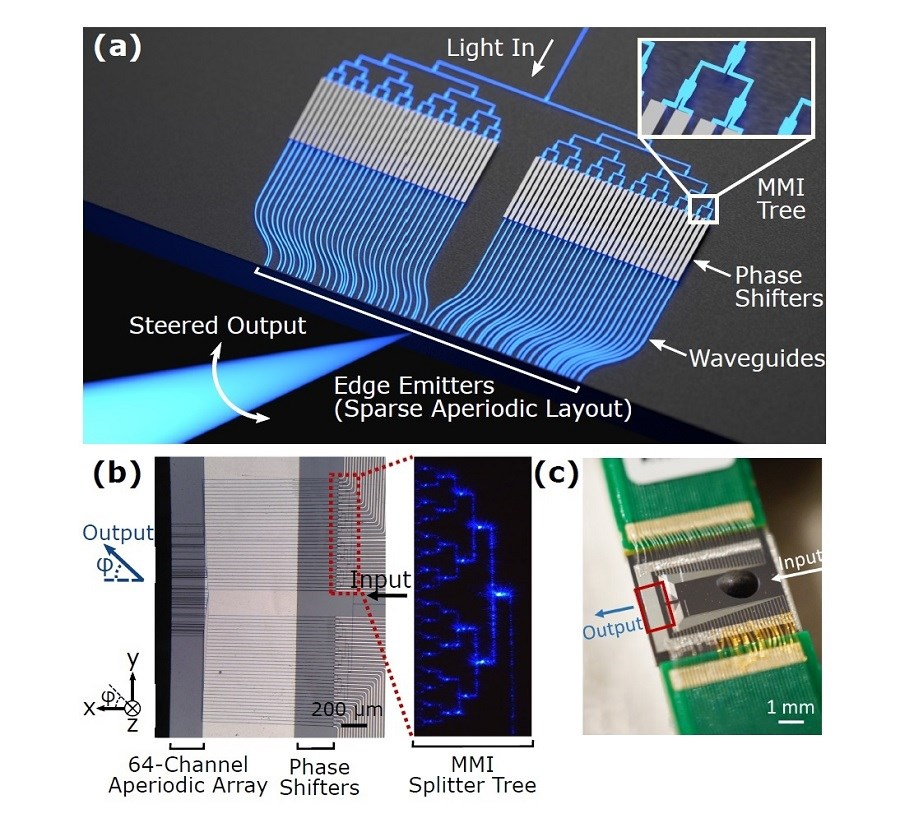Mar 20 2020
A novel chip-based device recently designed by scientists can shape and steer blue light without any moving parts. It is believed that the chip-based device can considerably decrease the size of light projection components, which are utilized in a diverse range of applications, including augmented reality.
 Researchers developed a new chip-based optical phased array that can shape and steer blue light with no moving parts. Image Credit: Min Chul Shin and Aseema Mohanty, Columbia University, and Myles Marshall, Secret Molecule.
Researchers developed a new chip-based optical phased array that can shape and steer blue light with no moving parts. Image Credit: Min Chul Shin and Aseema Mohanty, Columbia University, and Myles Marshall, Secret Molecule.
Our blue phased array platform can rapidly and precisely reconfigure visible light for many emerging applications, spanning holographic displays, quantum information processing and biological sensing and stimulation. It paves the way for chip-scale light projection across the entire visible range with a large field of view and can miniaturize the current bulky optical systems.
Michal Lipson, Research Team Leader, Columbia University
Lipson and collaborators have demonstrated the chip-based device in Optics Letters, the journal of Optical Society (OSA) journal. The chip-scale optical phased array (OPA) is the first to operate at blue wavelengths utilizing a silicon nitride platform. OPAs operate just like reconfigurable lenses by allowing random reconfigurations of three dimensional (3D) light patterns.
The latest OPA was created as part of a DARPA-supported project that is striving to develop a low power, lightweight head-mounted display that projects perceptible information onto the retina of the eye with a large field of view and ultra-high resolution. An augmented display like this cannot be achieved currently because the light projection components used for shaping and steering light have a reduced field of view and are also large.
Operating in the Visible
OPAs provide an alternative approach to massive light projection devices, which are usually produced using silicon., Silicon can only be utilized with near-infrared wavelengths.
Blue wavelengths need OPAs that are produced from a semiconductor material like silicon nitride that works at visible wavelengths. Still, the material and fabrication challenges have made it difficult to obtain a practicable blue OPA. To resolve this problem, the scientists have now improved the silicon nitride fabrication processes.
In the latest study, the researchers successfully produced a chip-based OPA by using the new platform.
Smaller wavelengths scatter more, resulting in higher light loss if the device fabrication is not perfect. Therefore, demonstrating an OPA that operates at blue wavelengths means we can achieve this across the entire visible range.
Min Chul Shin, Study Co-First Author, Lipson Nanophotonics Group, Columbia University
With the help of the novel blue light OPAs, the scientists showcased the beam steering across a 50-degree field of view and also demonstrated how this kind of platform could be advantageously used for image projection by creating two-dimensional (2D) images of letters.
All of the chips we have tested worked well. Large-scale integration of this system can be accomplished using today’s lithography techniques. Thus, this new platform introduces a platform for fully reconfigurable chip-scale 3D volumetric light projection across the entire visible range.
Aseema Mohanty, Study Co-First Author, Lipson Nanophotonics Group, Columbia University
Applications from Computing to Biology
The novel blue OPA may also prove to be andy to be used trapped ion quantum computers, which typically need lasers in the visible spectral range for optical stimulation at the micron-scale. Such trapped ion quantum computers are one of the most potential practical designs intended for quantum computing—an evolving technology that is anticipated to be considerably faster than that of conventional computing.
The novel chip-based devices may even be used in the field of optogenetics, in which, visible light is used to regulate neurons and other types of cells in living tissue. For instance, the devices can potentially be used for making an implantable device to activate light-sensitive tags on neurons used in animal disease models.
The scientists have planned to additionally regulate the electrical power consumption of the new OPA, since low-power operation is important for optogenetic applications and lightweight head-mounted augmented reality displays.